New Eyes, Old Ice: My First Glacier Experience
Last modified: 13th February 2020

- an essay by Mike Borden
- Arriving at Grewingk
- A Closer Look
- Motion in the Glacier
- Personal Reflection
an essay by Mike Borden
_
_
Never in my life had I seen a glacier. In fact, it wasn’t until my early 20’s that I even knew what they were. For me, a native Minnesotan, glaciers were like black holes, giant squid, or new Adam Sandler movies: I knew they existed but I wasn’t very likely to see one. It was for this reason that I jumped at the opportunity to lead a week long photojournalism trek to a glacier in south-central Alaska. With new eyes, I hoped to bring a fresh perspective to some very old ice.
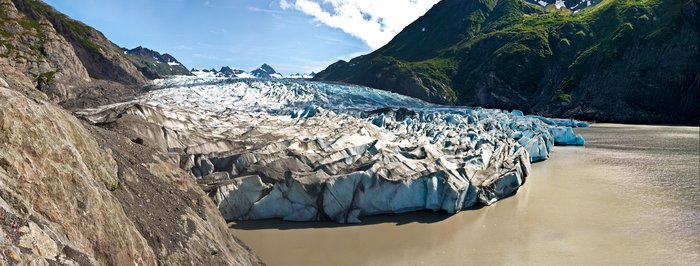
Arriving at Grewingk
Bjorn, Kim, and I kayaked, hiked, and packrafted 8 hours from Homer, Alaska to Grewingk Glacier - a massive glacier that descends through jagged peaks from the Harding Icefield. The view from camp justified the long day of travel: Grewingk was big and beautiful.
The snout of the glacier was about ½ mile wide and 40 feet tall. It was literally a cliff of ice. Lapping against its sheer face was a sun-warmed lake which slowly melted and eroded the ice of the glacier. Ice had once filled the whole basin, but as the glacier retreated, water took its place in this depression creating the terminus lake. This is a common sight at retreating glaciers and acts to accelerate their retreat.
The dramatic mass of ice that dominated my initial view seemed suddenly small when I got up high enough to see where that ice was flowing from. My eyes followed the glacier back into the mountains where it disappeared behind towering peaks and in some places even faded into the horizon. Its source was the Harding Icefield, the 4th largest subarctic icefield in the world. Grewingk is one of many glaciers that flow down through the mountains of the Kenai from the Harding, very much like rivers pouring out from a single, overflowing lake high in the mountains.
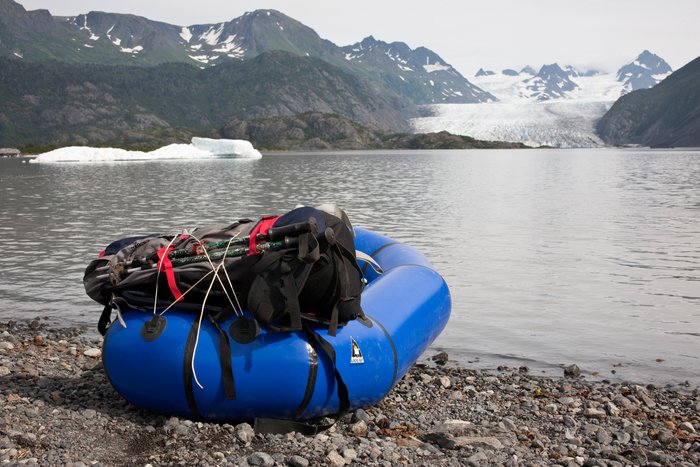
Glaciers are like giant, icy conveyor belts. High in the mountains, more snow falls than can melt. Over the years, it accumulates and compacts into ice. Eventually, so much ice accumulates that, under its own mass, it begins to flow. It baffles me that ice can flow. Geologists will tell you that even rock can flow if you put it under enough pressure, but ice occupies an unusual middle ground. It’s solid enough that it supports towering forms, but if there is a few hundred feet of ice on a slope it will start flowing. To aid in that flow, a thin layer of liquid water at the base of the glacier lubricates the rock beneath it and allows the ice to melt away from potential barriers. Though the flow of the glacier is so slow it is imperceptible, its great size means that it can move a whole winter’s snow and more out of the mountains in the span of a year.
A Closer Look
We paddled across the lake up to the snout of the glacier, fighting into the cold wind that poured down off of it. The face of Grewingk grew more distinct as we neared. In some places its face was flat, where slabs of ice had obviously sheared away cleanly. Wind and rain had polished the definition out of these surfaces. In these places, the ice was dull white with lines of dark sediment embedded within it. This ice was next in line to meet its warm, watery fate.
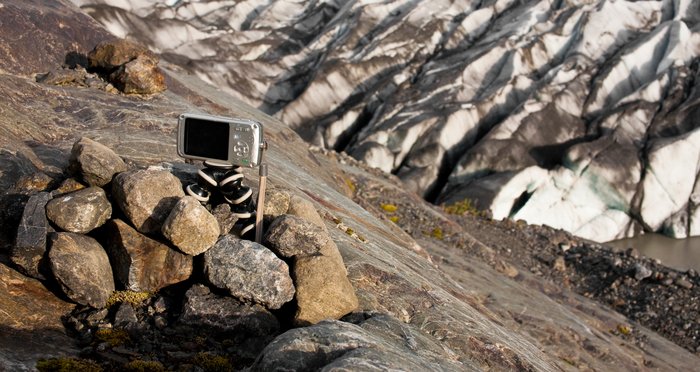
Grewingk’s towering snout was framed by a rocky, rugged shoreline, leading up to nearly-barren ridges once scoured by ice. On top of these ridges we set up time-lapse cameras. We then began to watch and wait, hoping to catch the almost imperceptibly moving glacier on camera.
Motion in the Glacier
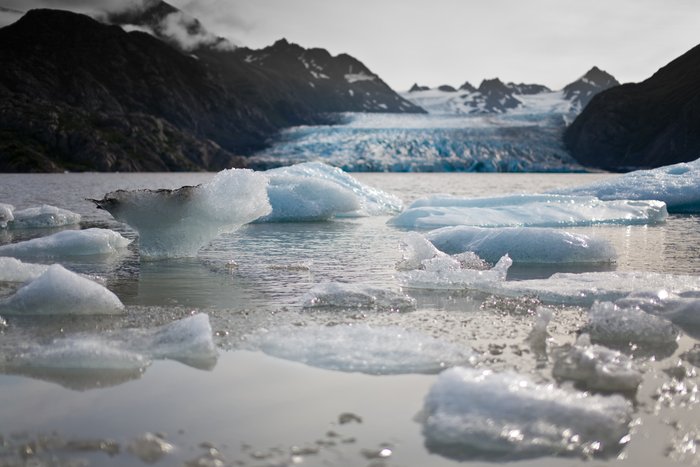
We were awoken by a muffled boom that had come from the glacier. We couldn’t see anything in the darkness but the waves near our campsite grew louder, washing further up on the shore. Out there in the dark, the glacier had moved.
We excitedly awoke the next morning to find that the tiny bay between us and the glacier had filled with ice.
The accumulation of ice was a stark change from the day before when the bay had been entirely ice free. Now it was filled with pancakes of shattered ice. We had undoubtedly experienced a calving event, which is when a mass of ice suddenly breaks off from the snout of a glacier.
As we paddled up to the glacier face, we saw the scar of the previous night’s calving: a once smooth part of the snout had been reduced to icy rubble. This left enormous frozen towers leaning precariously over the water.
The newly exposed ice gleamed a dull blue, as if a cold flame had been lit within the glacier. Glaciers are blue where the ice is the most dense and transparent. This is often visible in freshly exposed ice that hasn’t yet had a chance to relax. It’s blue because the air bubbles from between snowflakes are forced out or dissolved, creating large, clear ice crystals. As light passes through these ice crystals, the longer wavelengths are absorbed (red) and the shorter wavelengths are transmitted (blue).
Personal Reflection
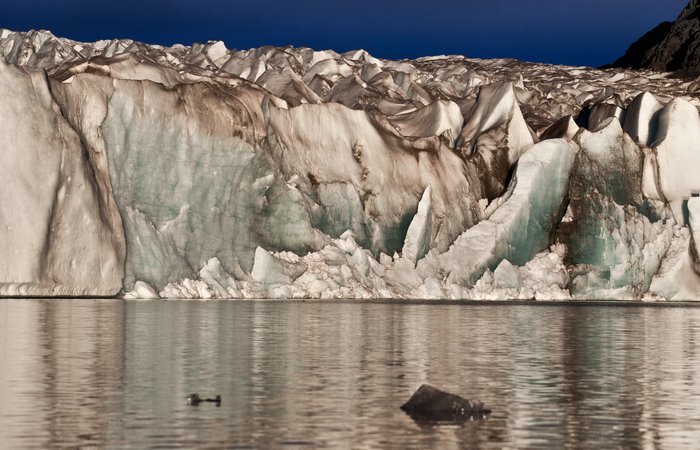
We spent a week at Grewingk glacier, shooting photography and exploring. I retrieved the last timelapse camera on the final day. Then my propensity for exploration got the better of me. I scrambled down the rocky slope to the ice’s edge, the air getting cooler as I approached. The towers of ice nearby made me feel like I was approaching an enormous frozen serpent, its giant scales radiating that deep cold blue. I had been watching and observing this icy behemoth since I arrived. But while my notebook was swollen with observations and my cameras were filled with pictures, I had not yet touched it. Part of the reason was because it was not exactly a safe place to be. Up close, the glacier was craggy and laden with crevices. In other places it was fragile and ice could give way when underfoot. To approach from the water was practically suicidal as a nearby calving event could be fatal. This hostile environment was no place for a casual hike. But I felt there was something to be gained by stepping foot on this glacier. I took one…two…three steps until I felt that the glacier was symbolically underfoot. On the back of this icy giant, I reflected on the week.
This trek had an element of Indiana Jones adventure: I didn’t know what I was going to find or encounter. It was like exploring an undiscovered temple or pyramid; glaciers were truly a mystery to me. After spending a week at Grewingk, they no longer had the “black hole” feel that they once did. I now understand their dynamic nature. I have a perspective for their immensity and a feeling for their incredible beauty. Most importantly, I feel that a hazy spot on my map of the world has now become clear. I have Grewingk to thank for that.
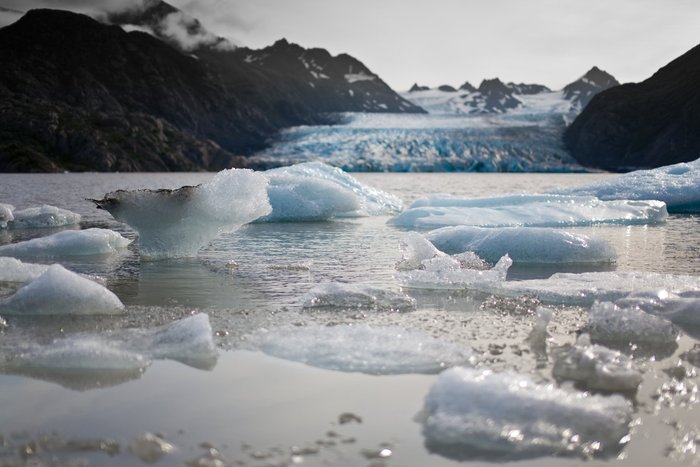
Created: Jan. 19, 2018